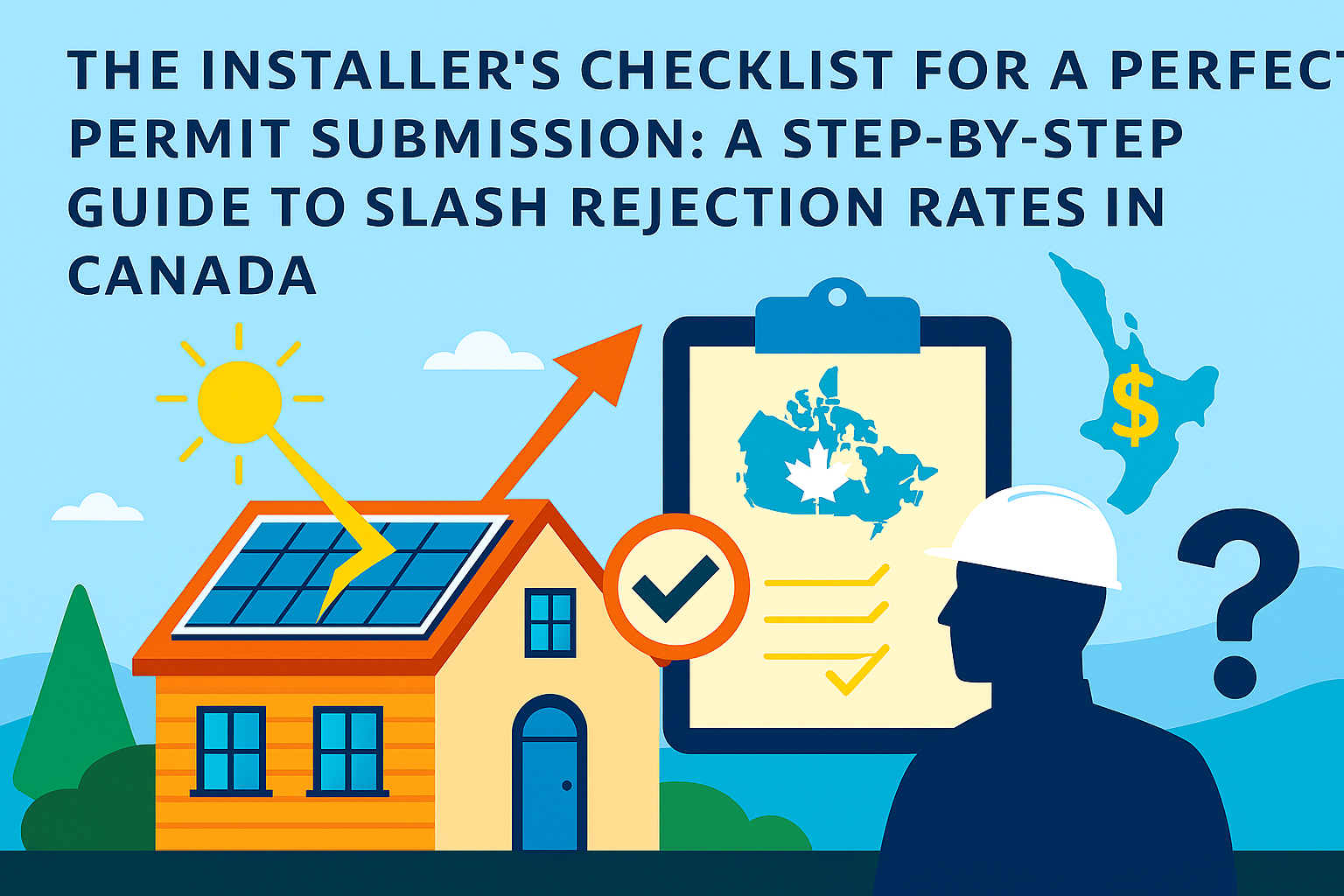Table of Contents
For solar installers, a permit rejection isn’t just a delay—it’s a direct hit to your timeline, budget, and client satisfaction. The key to a smooth, fast-tracked approval lies in understanding exactly what the Authority Having Jurisdiction (AHJ) looks for in a plan set.
In Canada, an AHJ is the organization, office, or individual responsible for enforcing the requirements of a code or standard. This can be a municipal building department, a provincial safety authority like Technical Safety BC or the ESA in Ontario, or even a zoning administrator. They have significant discretion in interpreting and applying codes, so giving them exactly what they need is your golden ticket to approval.
This step-by-step checklist will guide you through assembling a complete, compliant application that builds confidence with reviewers and drastically reduces your rejection rates.
Step 1: Lay the Foundation with Essential Project Documents
Before diving into the technical drawings, ensure these core documents are perfectly in order. Missing or incorrect information here is an immediate red flag.
- ✅ Complete Application Form: Fill out every section of the AHJ’s official application form. If a section does not apply, clearly mark it as “N/A” or “Not Applicable” to show it wasn’t overlooked.
- ✅ Site Plan: Provide a clear, scaled drawing showing the property and the proposed installation location. It must include:
- Property lines and dimensions.
- Location of all structures (house, garage, shed).
- Proposed location of solar array, inverter, and other major equipment.
- Setback distances from the roof edges and property lines.
- ✅ Proof of Homeownership: A copy of the land title or tax bill.
- ✅ Equipment Spec Sheets: Cut sheets for all major components—solar panels, inverters, racking systems, and any batteries. AHJs need to verify that the equipment is certified for use in Canada (e.g., by CSA, UL, or Intertek).
Step 2: Nail the Electrical Design Plan
This is the heart of your submission and where many applications fail. The electrical plan must demonstrate full compliance with the Canadian Electrical Code (CEC).
- ✅ Single-Line Diagram (SLD): This is non-negotiable. The SLD must clearly show:
- The complete circuit from the array to the point of interconnection.
- All components: PV modules, inverters, combiners, disconnects, and the main service panel.
- Correctly calculated voltage and current values, including maximum circuit current, voltage drop calculations, and fault current.
- Rapid shutdown system details in compliance with CEC.
- AC/DC disconnect locations, both at the inverter and for the utility.
- ✅ Wiring Details: Specify conductor types, sizes, and insulation ratings. Indicate conduit types, sizes, and routing methods.
- ✅ Grounding and Bonding: Provide a detailed plan for the grounding electrode system and equipment bonding. This is a critical safety element that AHJs scrutinize heavily.
- ✅ Load Calculations: If you are performing a service upgrade or adding a critical loads panel, include the electrical load calculations to prove the home’s service can handle the new system.
Step 3: Validate the Structural Integrity
The AHJ needs to be confident that the roof can safely support the additional load.
- ✅ Structural Stamp: In most Canadian jurisdictions, a roof-mounted system requires a sealed engineering stamp from a professional engineer licensed in that province. This is often the single most important document for building permit approval.
- ✅ Structural Letter & Calculations: The engineer’s package must include:
- Dead and live load calculations (snow, wind) are specific to the geographic location.
- Verification that the roof structure (rafters/trusses, sheathing) can support these loads.
- Details of the attachment method for the racking system to the roof structure.
Step 4: Secure External Approvals
Don’t let your application stall because you’re waiting on a third party.
- ✅ Utility Interconnection Agreement: For any grid-tied system, you must include proof of application or, even better, approval from the local utility (e.g., BC Hydro, Hydro-Québec, Toronto Hydro) . This covers:
- Net metering agreement.
- Interconnection study (if required by the utility).
- ✅ Zoning and Setback Compliance:** Confirm the installation complies with local zoning bylaws regarding height, setback from roof edges, and visibility. This is especially important in dense urban areas or for ground-mount systems.
The Golden Rules for a Flawless Submission
- Communicate Early: Before you even submit, consider a pre-application meeting with the AHJ for complex projects. This builds rapport and gives you direct insight into their specific expectations.
- Be Meticulous: Sloppy, inconsistent, or incomplete drawings signal a sloppy installation. Use clear labels, consistent symbols, and legible fonts. Double-check that all values on your SLD match the equipment spec sheets.
- Know Your Province: While the CEC is national, enforcement is provincial. An application in Ontario is reviewed by the Electrical Safety Authority (ESA), while in British Columbia, it’s Technical Safety BC. Tailor your application to the specific provincial authority.
What Happens If You Skip a Step?
Cutting corners is a costly gamble. An incomplete or incorrect application can lead to :
- Weeks of Delays: Each resubmission cycle can take 2-4 weeks.
- Forfeited Rebates: Clients may miss out on federal or provincial incentives that require proof of permit approval.
- Fines and Liability: You and the homeowner could face retroactive fines, and the system could be flagged as unpermitted, voiding insurance coverage.
By treating the permit application not as bureaucratic paperwork but as the first critical phase of your installation, you demonstrate professionalism, build trust with AHJs, and ensure your projects move forward smoothly and profitably.
